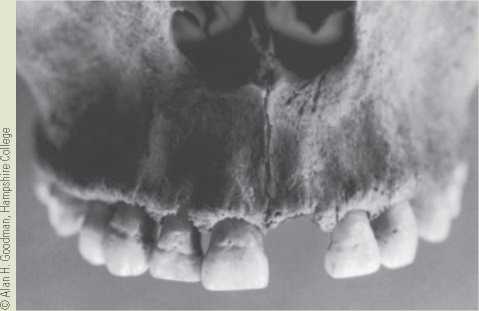Although we tend to think of the invention of food production in terms of its cultural impact, it obviously had a biological impact as well. From studies of human skeletons from Neolithic burials, physical anthropologists have found evidence for somewhat less mechanical stress on peoples’ bodies and teeth. Although there are exceptions, the teeth of Neolithic peoples show less wear, their bones are less robust, and osteoarthritis (the result of stressed joint surfaces) is not as marked as in the skeletons of Paleolithic and Mesolithic peoples.
Though Neolithic teeth show less wear, recent discoveries from Pakistan provide the earliest evidence of human dentistry: tiny holes made in the molar teeth of ancient live humans, with fine flint drills.24 Whether dentistry accompanied an increase in dental decay brought about by the dietary shift of this period remains to be seen. This would parallel the clear evidence for a marked overall deterioration in health and mortality during the Neolithic. Anthropologist Anna Roosevelt sums up our knowledge of this in the following Original Study.
24 Coppa, A., et al. (2006). Early Neolithic tradition of dentistry. Nature 440, 755-756.

Original Study
History of Mortality and Physiological Stress by Anna Roosevelt

Harris lines near the ends of these youthful thigh bones, found in a prehistoric farming community in Arizona, are indicative of recovery after growth arrest, caused by famine or disease.
Although there is a relative lack of evidence for the Paleolithic stage, enough skeletons have been studied that it seems clear that seasonal and periodic physiological stress regularly affected most prehistoric hunting-gathering populations, as evidenced by the presence of enamel hypoplasias [horizontal linear defects in tooth enamel] and Harris lines [horizontal lines near the ends of long bones].
What also seems clear is that severe and chronic stress, with high frequency of hypoplasias, infectious disease lesions, pathologies related to iron-deficiency anemia, and high mortality rates, is not characteristic of these early populations. There is no evidence of frequent, severe malnutrition, and so the diet must have been
Adequate in calories and other nutrients most of the time.
During the Mesolithic, the proportion of starch in the diet rose, to judge from the increased occurrence of certain dental diseases, but not enough to create an impoverished diet. At this time, diets seem to have been made up of a rather large number of foods, so that the failure of one food source would not be catastrophic. There is a possible slight tendency for Paleolithic people to be healthier and taller than Mesolithic people, but there is no apparent trend toward increasing physiological stress during the Mesolithic. Thus, it seems that both hunter-gatherers and incipient agriculturalists regularly underwent population pressure, but only to a moderate degree.
During the periods when effective agriculture first comes into use, there seems to be a temporary upturn in health and survival rates in a few regions: Europe, North America, and

Enamel hypoplasias, such as those shown on these teeth, are indicative of arrested growth caused by famine or disease. These teeth are from an adult who lived in an ancient farming community in Arizona.
The eastern Mediterranean. At this stage, wild foods are still consumed periodically, and a variety of plants are cultivated, suggesting the availability of adequate amounts of different nutrients. Based on the increasing frequency of tooth disease related to high carbohydrate consumption, it seems that cultivated plants probably increased the storable calorie supply, removing for a time any seasonal or periodic problems in food supply.
In most regions, however, the development of agriculture seems not to have had this effect, and there seems to have been a slight increase in physiological stress.
Stress, however, does not seem to have become common and widespread until after the development of high degrees of sedentism, population density, and reliance on intensive agriculture. At this stage in all regions the incidence of physiological stress increases greatly, and average mortality rates increase appreciably.
Most of these agricultural populations have high frequencies of porotic hyperostosis and cribra orbitalia [bone deformities indicative of chronic iron-deficiency anemia], and there is a substantial increase in the number and severity of enamel hypoplasias and pathologies associated with infectious disease. Stature in many populations appears to have been considerably lower than would be expected if genetically determined height maxima had been reached, which suggests that the growth arrests associated with pathologies were causing stunting.
Accompanying these indicators of poor health and nourishment, there is a universal drop in the occurrence of Harris lines, suggesting a poor rate of full recovery from the stress. Incidence of carbohydrate-related tooth disease increases, apparently because subsistence by this time is characterized by a heavy emphasis on a few starchy food crops. Populations seem to have grown beyond the point at which wild food resources could be a meaningful dietary supplement, and even domestic animal resources were commonly reserved for farm labor and transport rather than for diet supplementation.
It seems that a large proportion of most sedentary prehistoric populations under intensive agriculture underwent chronic and life-threatening malnutrition and disease, especially during infancy and childhood. The causes of the nutritional stress are likely to have been the poverty of the staple crops in most nutrients except calories, periodic famines caused by the instability of the agricultural system, and chronic lack of food due to both population growth and economic expropriation by elites. The increases in infectious disease probably reflect both a poorer diet and increased interpersonal contact in crowded settlements, and it is, in turn, likely to have aggravated nutritional problems.
Adapted from Roosevelt, A. C. (1984). Population, health, and the evolution of subsistence: Conclusions from the conference. In M. N. Cohen & G. J. Armelagos (Eds.), Paleopathology at the origins of agriculture (pp. 572-574). Orlando: Academic Press.
For the most part, the crops on which Neolithic peoples came to depend were selected for their higher productivity and storability rather than their nutritional value. Moreover, as already noted, their nutritional shortcomings would have been exacerbated by their susceptibility to periodic failure, particularly as populations grew in size. Thus the worsened health and mortality of Neolithic peoples are not surprising. Some have gone so far as to assert that the switch from food foraging to food production was the worst mistake that humans ever made.
Another key contributor to the increased incidence of disease and mortality was probably the new mode of life in Neolithic communities. Sedentary life in fixed villages brings with it sanitation problems as garbage and human waste accumulate. These are not a problem for small groups of people who move about from one campsite to another. Moreover, airborne diseases are more easily transmitted where people are gathered into villages. As discussed in Chapter 2, farming practices also created the ideal environment for the species of mosquito that spreads malaria.
Another factor, too, was the close association between humans and their domestic animals, a situation conducive to the transmission of diseases. A host of life-threatening diseases—including smallpox, chicken pox, swine flu, and many of those infectious diseases of childhood that were not overcome by medical science until the latter half of the 20th century—were transmitted to humans through their close association with domestic animals (Table 10.1). Higher mortality rates in Neolithic villages were offset by increased fertility, for population growth accelerated dramatically at precisely the moment that health and mortality worsened.
Diseases Acquired from Domesticated Animals
|
Human Disease |
Animal with Most Closely Related Pathogen |
Deaths Globally According to WHO (Year) |
Prevention Strategies |
|
Measles |
Cattle (rinderpest) |
197,000 (2007) |
Immunization |
|
Tuberculosis |
Cattle |
1.6 million (2005) |
Treatment of infected individuals to prevent spread |
|
Smallpox |
Cattle (cowpox) or other livestock with related pox viruses |
Eradicated as of December 1979; between 1900 and eradication, smallpox killed 300-500 million people |
Immunization |
|
Influenza |
Pigs, ducks |
Several different types; all are seasonal and variable, with 250,000 to 500,000 deaths estimated annually |
Immunization |
|
Pertussis (whooping cough) |
Pigs, dogs |
297,000 (2000) |
Immunization |
Source: Diamond, J. (1997). Guns, germs, and steel (p. 207). New York: Norton; World Health Organization Fact Sheets.




 World History
World History









